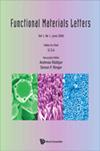Simulation and Fabrication of Titanium dioxide thin films for supercapacitor electrode applications
IF 1.1
4区 材料科学
Q4 MATERIALS SCIENCE, MULTIDISCIPLINARY
引用次数: 0
Abstract
Nanostructured thin-film electrode materials are proposed for supercapacitors due to their outstanding performance over bulk materials. In this work, we fabricated a TiO 2 nanotube film over a titanium foil using a top-down approach for supercapacitor electrodes. We noticed that the fabricated nanotubes are uniform and well aligned, confirmed by FESEM; the TiO 2 nanotube parameters were further simulated using COMSOL Multiphysics. Simulations show an areal capacitance of 1.19393 pF/cm 2 with oxidation and reduction peak currents of 6.18921 × 10[Formula: see text] A and − 6.0320 × 10[Formula: see text] A, respectively, at 10 mV/s scan rate. The as-prepared nanotubes show a poor areal capacitance of 1.0193 F/cm 2 , which is improved to 12.8764 F/cm 2 at a scan rate of 10 mV/s, that is approximately 12.63 times with oxidation and reduction peak currents of 0.129 mA/cm 2 and − 0.105 mA/cm 2 , respectively, by performing an electrochemical etching. Further, the surface roughness of both as-prepared and etched samples is studied to comment on their surface area changes. The effect of the etched sample is studied, compared and validated with simulation, which reveals that the etched TiO 2 nanotubes thin-film sample shows considerable similarity with the simulation results.超级电容器电极用二氧化钛薄膜的模拟与制备
纳米结构薄膜电极材料由于其优于块状材料的性能而被提出用于超级电容器。在这项工作中,我们采用自顶向下的方法在钛箔上制备了二氧化钛纳米管薄膜,用于超级电容器电极。我们注意到制备的纳米管均匀且排列良好,通过FESEM证实;利用COMSOL Multiphysics进一步模拟了tio2纳米管的参数。仿真结果表明,在10 mV/s扫描速率下,面电容为1.19393 pF/ cm2,氧化和还原峰值电流分别为6.18921 × 10和- 6.0320 × 10[公式:见文]。制备的纳米管的面电容为1.0193 F/cm 2,当扫描速率为10 mV/s时,其面电容提高到12.8764 F/cm 2,在氧化和还原峰值电流分别为0.129 mA/cm 2和- 0.105 mA/cm 2时,其面电容提高了约12.63倍。此外,研究了制备样品和蚀刻样品的表面粗糙度,以评价它们的表面积变化。对刻蚀样品的影响进行了研究,并与模拟结果进行了比较和验证,结果表明刻蚀后的tio2纳米管薄膜样品与模拟结果具有相当的相似性。
本文章由计算机程序翻译,如有差异,请以英文原文为准。
求助全文
约1分钟内获得全文
求助全文
来源期刊

Functional Materials Letters
工程技术-材料科学:综合
CiteScore
2.40
自引率
7.70%
发文量
57
审稿时长
1.9 months
期刊介绍:
Functional Materials Letters is an international peer-reviewed scientific journal for original contributions to research on the synthesis, behavior and characterization of functional materials. The journal seeks to provide a rapid forum for the communication of novel research of high quality and with an interdisciplinary flavor. The journal is an ideal forum for communication amongst materials scientists and engineers, chemists and chemical engineers, and physicists in the dynamic fields associated with functional materials.
Functional materials are designed to make use of their natural or engineered functionalities to respond to changes in electrical and magnetic fields, physical and chemical environment, etc. These design considerations are fundamentally different to those relevant for structural materials and are the focus of this journal. Functional materials play an increasingly important role in the development of the field of materials science and engineering.
The scope of the journal covers theoretical and experimental studies of functional materials, characterization and new applications-related research on functional materials in macro-, micro- and nano-scale science and engineering. Among the topics covered are ferroelectric, multiferroic, ferromagnetic, magneto-optical, optoelectric, thermoelectric, energy conversion and energy storage, sustainable energy and shape memory materials.
 求助内容:
求助内容: 应助结果提醒方式:
应助结果提醒方式:


